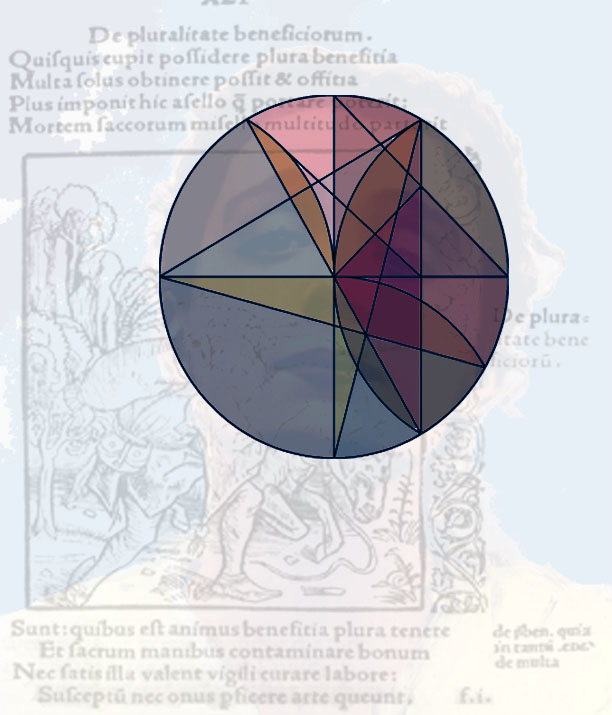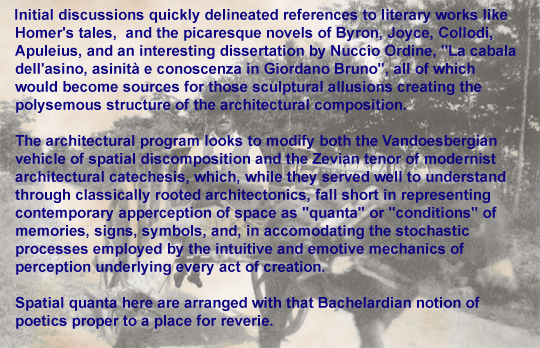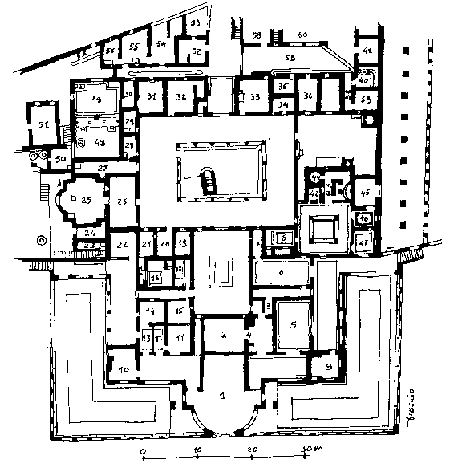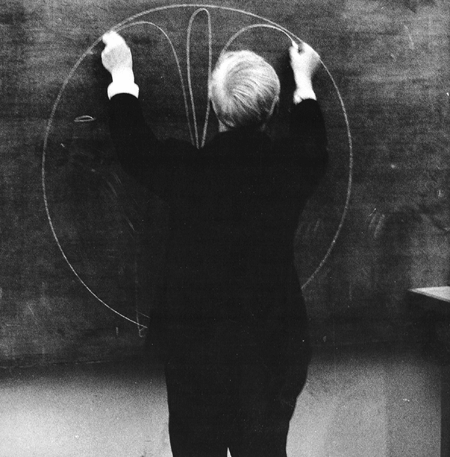Diagraphics of Geometrical Footprint (ichnography):
Shelter for a caravan of mules. Blue Sea, Québec, 02/2001The Blue Sea area of Quebec, just north of Ottawa, Ontario, a primordial sea, now a bush-filled, gently sinusoidal valley quilted with grassy dells and ringed by tree-mantled hillocks, is one of the splendours of Canada's bush-garden, and territory of the proud Algonquin tribe. Of its unmatched beauty one can certainly say what the Poet said of the region of the proud Veneti, that it is "la macchia della bellezza e del'amore" ["the place of ever-verdant beauty and love"] (Dante Alleghieri).
C'era una volta... A Joycean man, a d'Annunzian woman, who, in full life, and in observance of their commonly shared view of it being a "caravan of heavily laden mules", returning near their places of origin to make a mark (ïknos) and take on the exciting new challenges of old age, called upon maestro 1 Sbrissa, architetto.

" e nulla torna se non forse in questi disguidi del possibile"
... E. Montale
The above ichnographic composition is a preliminary outline of the inter-relationships of spaces (forms(functions)). This geometrical "net" or symbolic finite rhyzome becomes the placeholder for those spacial quanta whose thematic content, through controlled juxtapositions and architectonic inter-connections, are to educe proleptic and retroactive trajectories of meaning (memories).
"Dolci case di contadini
piene di silenzi
pietra su pietra e legno filtrate
ombre di ricordi e generazioni.
Case scolinanti dai solchi,
curve come grandi madri
a porgere dal seno affetto
nel riposo dell'aie.
... Italo FacchinelloWe shall not cease from exploration
And the end of all our exploring
Will be to arrive where we started
And know the place for the first time.
Through the unknown, remembered gate
When the last of earth left to discover
Is that which was the beginning;
At the source of the longest river
The voice of the hidden waterfall
And the children in the apple-tree
Not known, because not looked for
But heard, half heard, in the stillness
Between the two waves of the sea.
Quick now, here, now, always--
-- T.S. Eliot (1943)
from Little Gidding V, Four QuartetsThus apperception is attained through the awakening and confronting of the sets of psycho-physical "deferred actions" 2 which in this case are manifestations of the symbolic contents of the burdens carried by the individual mules3. In such a way, through forming, a sculptural vehicle, crucible, and speculum, representing containing and reflecting allusions to the erotic 4 mysteries of its ideators, is fabricated.
To unfold 5 is not an architecture for passive appreciation, or one for occasional isolated contemplation, but rather, one of encounters in which the participant is not only challenged but elicited to identify and enumerate those challenges, and the psychical, temporal, causal and perceptual levels on which they stimulate ones "artificial imagination"6. It is a concept alluding to precedents7 like La Villa Dei Misteri in Pompeii 8, and Barbaro's Villa Maser, on one hand and Giordano Bruno's 9 speculations on the design of theatres, and Henri Bosco's "L'Antiquaire" (Gallimard, 1954) on the other, and of course, il piacere (eros) architettonico:
"all'Ideale che non ha tramonti, // to the Ideal that knows no seting sun
alla Bellezza che non sa dolori!" // to the Beauty that knows no pain!)
-- Francesco Paolo Michetti
___________
1. At qui utrumque perdidicerunt, uti omnibus armis ornati citius cum auctoritate, quod fuit propositum, sunt adsecuti.
He who is theoretic as well as practical, is therefore doubly armed; able not only to
prove the propriety of his design, but equally so to carry it into execution.
(terrible translation, not mine, but it will do for now) Vitruvius. Ch.I, Ten Books...2. Deferred Action (Nachträglichkeit)
Term frequently used by Freud in connection with his view of psychical temporality and causality; experiences, impressions and memory-traces may be revised at a later date to fit in with fresh experiences or with the attainment of a new stage of development. They may in that event be endowed not only with a new meaning but also with psychical effectiveness.3. "No other creature is capable, like man, to create its own image in a symbolic manner which reflects and at the same time transcends his immediate environment" --Lewis Mumford
4. We're not restricting meaning to carnality here, but rather of "soul", its relation to its physico-psycho-socio-cultural geography, and its capacity to rhetorically emote its self-awareness through the luminant effects1 of the things it does and make through action in beauty. A Platonic position.
"All our awareness is grounded in forms of spatial experience and that spatial experience is not pure but charged with emotional stress from our initiation to 'first-born affinities'. There is a domain of experience, born before the use of words, yet structured like a language replete with its own expectations, memory and powers of communication: a domain that is indeed the primary source of the one language that is truly universal and to which we have given the name of 'body language'. The structure of this primordial language is ordered in terms of two complementary psychological 'positions' in which spatial, sensual and psychological components are linked in a code that is, in turn, reflected in mirror symmetry with our experience of the primary forms of architecture."5. "A world, a glimmer, or a flower? Glimmering and trembling, trembling and unfolding, a breaking light, an opening flower, it spread in endless succession to itself, breaking in full crimson and unfolding and fading to palest rose, leaf by leaf and wave of light by wave of light, flooding all the heavens with its soft flushes, every flush deeper than the other."
---Colin St. John Wilson, "The Natural Imagination", Architectural Review, Jan. 1989, Vol. 185 #1103Architecture, as the father of renaissance architecrure, Bramante, maintained, is the "complete celebration of Beauty".
_________
1. "...More shimmery, as if I'd painted the shimmering protoplasm in the leaves and everywhere, and not the stiffness of the shape. That seems dead to me. Only this shimmeriness is the real living. The shape is a dead crust. The shimmer is inside really.
--Paul, the artist, in D. H. Lawrence's Sons and Lovers, Penguin Books. , p. 189.
--- James Joyce, Portrait of an Artist as a Young Man, Penguine Books, p.1726. The realm of architectural discourse today is much possessed by death and by the notion of architecture as the embodiment of memory. In so far as Memory, 'Mnemosyne' in Greek mythology, is the Mother of the Arts it is the very source of that mode of the architectural imagination that feeds upon artifice and reflection--the whole culture of conventions, mythical and stylistic, that in turn transmutes the day-to-day transactions of utility and the prevailing lore of technology into symbolic statement. It is the world of ideal form, of abstraction and allusion and manner woven from a history that is unique in time and place; and what it draws upon is that body of knowledge and sensibility that we will call the Artificial Imagination.
--- Colin St. John Wilson, op.cit7. Precedents here are recalled and their relevance distilled or abstracted. They are not literally employed like is the habit of architetural epistemologists.
8. Villa Dei Misteri, Pompei, Italy
9. Bruno, Giordano 1548-1600.
Italian writer/pedagogue (tutor to the Court of France, and first professor to illuminated Oxford University, found an elective afinity in William Shakespeare who befriended him (while in exile)) who used Copernican principles to masque his ontological leanings. Condemned by the Inquisition for heresy, immoral conduct, and blasphemy, he was burned at the stake. Thought of by some historians like Frances Yates to be a key figure in the flourishing of the Venetian Renaissance which was distincly different to the Florentine one flavoured by Aquinian theological principals, and which eventualy overtook the Florentine to become in its liberal manifestation, the Italian High Renaissance.
Cecilia Wilde



